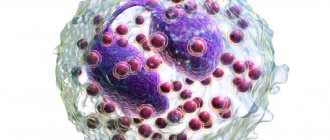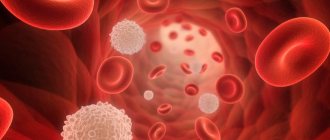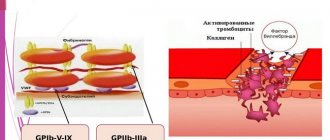Children are always under closer medical attention, since in childhood people are most susceptible to various infections due to their immune defenses not being fully formed. Any routine examination necessarily includes a general blood test, which allows pediatricians to assess the child’s condition and suspect the development of pathology at an early stage. One of the main blood indicators is the platelet level. These small, irregularly shaped plates are responsible for blood clotting, stopping bleeding and restoring the vascular wall. If platelets are elevated in the blood test, additional examination is required to determine the cause and further treatment.
What are platelets
Before you begin deciphering the analysis, it is worth understanding what platelets are.
Platelets are blood platelets, the smallest formed elements of blood. The formed elements of blood also include leukocytes and erythrocytes. Together with platelets, they make up the bulk of blood cells.
The functions of platelets are very diverse, but their role in the body is to control the performance of blood vessels by releasing various biological substances. The well-known function of platelets is their participation in the blood clotting process. In this case, platelet levels are associated with the formation of bleeding and blood clots.
Causes of thrombocytosis
Thrombocytosis can be caused by:
- increased production of blood platelets by megakaryocytes of the red bone marrow (with erythremia);
- slow platelet utilization (when the spleen is removed);
- disturbance of the distribution of platelets in the bloodstream (due to physical or mental stress).
When an elevated platelet count is detected, it is very important to determine the cause of this condition. Only a pediatrician or hematologist (a specialist in blood diseases) can identify this cause.
Thrombocytosis as a disease can develop in children at any age. But such a diagnosis is made with a significant increase in the number of platelets - more than 800 thousand/l. More often, a mild increase in the number of blood platelets occurs due to a number of reasons or in a number of diseases.
There are primary , clonal and secondary thrombocytosis.
With clonal thrombocythemia, there is a defect in the stem cells themselves in the bone marrow (they are damaged by the tumor process). They do not respond to stimulation of the process by the endocrine system, and the process of platelet formation becomes uncontrollable.
A similar mechanism is observed in primary thrombocythemia . It is associated with the proliferation of several areas of the red bone marrow and, as a consequence, with an increase in the number of newly formed blood platelets. The causes of this condition can be hereditary (congenital) diseases or acquired (myeloid leukemia, erythremia).
In primary thrombocytosis, the number of blood platelets can vary: from a slight increase to several million in 1 μl, but high levels are more typical. In addition, their morphology also changes: platelets of enormous size and altered shape are found in the blood smear.
The mechanism of development of secondary thrombocytosis can be different:
- when the spleen is removed, old or obsolete platelets do not have time to destroy, and new ones continue to form; in addition, the spleen produces antiplatelet antibodies and a humoral factor that inhibits platelet production;
- During the inflammatory process, the body intensively produces a hormone (thrombopoietin), which promotes the maturation of blood platelets, which help cope with inflammation; biologically active substances (for example, interleukin-6) are anti-inflammatory cytokines that stimulate platelet synthesis;
- in malignant diseases, the tumor produces biologically active substances that have a stimulating effect on bone marrow megakaryocytes and the production of blood platelets; this is more often observed in lung sarcoma, kidney hypernephroma, lymphogranulomatosis;
- thrombocytosis also develops as a response of the body to repeated blood loss (with ulcerative lesions of the intestine, with cirrhosis of the liver),
Secondary thrombocythemia (symptomatic or reactive) can develop in a number of diseases:
- tuberculosis;
- iron deficiency or hemolytic anemia;
- rheumatism in the active stage;
- ulcerative colitis;
- osteomyelitis;
- chronic and acute infections (viral, bacterial, fungal, parasitic);
- extensive surgical interventions;
- removal of the spleen (for injuries or hemophilia);
- acute blood loss;
- fractures of tubular bones;
- cirrhosis of the liver;
- amyloidosis;
- malignant diseases.
Secondary thrombocytosis is characterized by a less pronounced increase in the number of platelets: in very rare cases, their number exceeds a million in 1 μl. The morphology and function of blood platelets are not impaired.
In any case, detected thrombocytosis requires a full examination and clarification of the cause of its occurrence.
In addition to diseases, it can also be caused by side effects of medications (Vincristine, epinephrine, adrenaline, corticosteroids, etc.). There are no specific symptoms of thrombocytosis.
When an increased platelet count is initially detected, the following studies must be performed:
- determination of serum iron and serum ferritin;
- determination of C-reactive protein and seromucoids;
- blood coagulation analysis;
- Ultrasound of the abdominal and pelvic organs;
- if necessary, consult a hematologist;
- bone marrow examination (only as prescribed by a hematologist).
Conditions in which platelets are elevated in a child
An increased number of platelets in the blood is called thrombocytosis.
The reasons for their increased level may be:
- enhanced hematopoietic processes in the bone marrow , which leads to a high concentration of platelets in the blood and other formed elements;
- high platelet consumption , resulting in a compensatory increase in their number;
- infectious process (tuberculosis);
- taking medications and others.
A high level of platelets in the blood is dangerous because it thickens the blood and increases the risk of blood clots. Only a doctor can tell you more accurately whether a child’s platelets are elevated or not.
Treatment of thrombocytopenia
Thrombocytopenia is treated by a hematologist. The treatment regimen is developed individually for each patient: the patient’s age, the presence of any diseases, the degree of deficiency, and the amount of bleeding are taken into account. It is necessary to determine the cause of thrombocytopenia so that treatment is as effective as possible. Standard drug therapy consists of:
- Corticosteroids – have anti-inflammatory and analgesic effects;
- Immunoglobulins – correct the functioning of the immune system;
- Immunosuppressants – stop the destructive effect of the immune system on the body;
- Agonists to thrombopoietin receptors – promote more active production of this hormone.
In case of thrombocytopenia caused by bleeding, it is necessary to identify the source of this bleeding and stop it. Only after this the platelet correction is carried out. The patient will have to take medicinal iron and drugs that promote the production of red blood cells.
If drug treatment does not produce any results, splenectomy is indicated - surgical excision of the spleen. For hereditary diseases that prevent the body from producing enough platelets, a bone marrow transplant is necessary. If the platelet level is critically low, a blood transfusion of platelet mass from a donor is performed. If a large volume of blood is lost, a transfusion of fresh frozen plasma and red blood cells is necessary.
Low platelet count
A few words should be said about low platelet levels. Low platelet count in the blood – thrombocytopenia. Due to the fact that platelets take part in blood clotting processes, a lack of them in the blood can lead to bleeding.
The reason for a low platelet count in the blood may be, for example, inhibition of bone marrow hematopoiesis as a result of radiotherapy or if there are factors leading to their destruction in the blood. The latter may include autoimmune diseases. There are cases when thrombocytopenia is hereditary, for example, Wiskott-Aldrich syndrome, Bernard-Soulier syndrome .
You can tell that your child has platelet problems by the presence of a rash or bruises that quickly appear when touched.
Indications
This blood test is prescribed if the child has the following complaints:
- gums bleed;
- the nose often bleeds;
- with cuts and scratches the bleeding does not stop for a long time;
- bruises quickly form on the body.
All of the above conditions indicate a low content of blood platelets.
It is almost impossible to suspect that platelets are elevated. As a rule, thrombocytosis is detected during routine examination. The child may complain:
- for swelling of the extremities;
- for fatigue;
- for periodic pain in the legs and arms.
It is imperative to monitor platelet levels in the following diseases in a child:
- iron deficiency and B12 deficiency anemia;
- systemic lupus erythematosus;
- enlarged spleen;
- infectious diseases of viral origin;
- lymphogranulomatosis;
- leukemia;
- leukemia.
To determine the cause of thrombocytosis in a child, a number of examinations are required, including:
- carrying out blood tests three times at intervals of several days;
- blood test for C-reactive protein;
- Analysis of urine;
- blood test for iron content;
- ultrasound examination of internal organs.
Test to determine the level of platelets in the blood
What tests can be prescribed, including counting platelet levels in the blood? One of these tests is a general clinical blood test. This is a study of the level of red blood cells, white blood cells and platelets together. Depending on the equipment the laboratory is equipped with, other blood parameters may be determined.
Most often, a hematology analyzer is used for general clinical blood analysis. Therefore, there are a number of factors influencing the reliability of the results.
Sometimes, if the indicators are inadequate or questionable and do not correspond to the clinical picture, a separate study of platelet levels may be prescribed. It is carried out manually, and in this case it is more reliable, as it helps to avoid erroneous readings from the device.
Mechanism of action
It may seem strange that such tiny blood cells play such a significant role in the functioning of the body. How does this happen?
The bottom line is this: platelets accumulate in large numbers where there is tissue damage, accompanied by blood loss. Here they connect and collapse, forming a protective sphere in the form of a blood clot, which stops the bleeding.
- Platelets are elevated in an adult - what does this mean, and how to reduce them?
In addition to performing this function, blood platelets provide nutrition to the protective layer of blood vessels - the endothelium.
How to prepare properly
One of the important components when preparing for a general blood test is the emotional calm of mother and child.
Drawing blood is stressful and can lead to fluctuations in your readings, so it’s best to be mentally prepared for it. Blood must be donated on an empty stomach. But in infants this is difficult to comply with, so it is allowed to donate the material between feedings.
Also, the child’s hands should not be cold. At low temperatures, the capillaries spasm, blood flow slows down, and the procedure may be delayed.
It is important to sit or lay the child down so that he is comfortable.
How is blood taken from children for platelets?
Blood is taken from a finger (sometimes from a vein) on an empty stomach in the morning. A sample is taken from the heel or toes of an infant. No special preparation is required before donating blood. The main thing is not to feed the child before the procedure; you are only allowed to drink plain water. Several factors may affect the results. This is eating in the morning before the test, taking medications, severe stress, physical activity the day before, severe hypothermia. In this case, the result may be distorted.
Where to get tested for free and for a fee
If you have a compulsory medical insurance (compulsory health insurance) policy, you will be able to test the level of platelets in your blood free of charge. If suddenly, for some reason, you do not have the desire or opportunity to visit your medical institution to which you are attached, then you can contact any medical center that provides paid services.
Features of the manifestation of the pathological condition
High platelet counts disrupt the functioning of the child’s body.
In this case, parents may recognize the following symptoms:
- Periodic occurrence of bleeding from the nasal cavity.
- Parents will be able to see blood streaks in the child's stool.
- Systematic tingling or pain appears at the fingertips.
- Bruises appear on the skin. In this case, the obvious reasons for the process are completely absent.
- The baby's vision is deteriorating.
- The baby is constantly in a lethargic and apathetic state.
Increased platelets are very dangerous. If these negative manifestations occur, it is recommended to immediately seek advice from your doctor. The situation requires immediate diagnosis and treatment, otherwise the risk of serious complications increases.
How much does platelet determination cost in Moscow laboratories?
Determining the number of platelets during a general clinical blood test in laboratories in Moscow will cost you 250-400 rubles; in addition, you may be required to pay money for taking blood. To avoid being deceived, visit the website of a specific medical center. There is almost always a price list there.
You can also additionally request a manual method of platelet counting (according to Fonio). It will cost you somewhere around 200-300 rubles. Some medical centers do not separately conduct manual platelet level testing, only as an additional method. Therefore, you need to be prepared for this.
Decoding indicators
When receiving the research results in person, for example, in a paid center, many parents immediately begin to explore the Internet. They check the level of platelets in the blood using unreliable sources, make their own conclusions, and prescribe treatment.
Parents who care about the health of their child will turn to a specialist, for example, a pediatrician or hematologist, for a transcript of the analysis. If deviations are detected, the patient will be referred to additional research methods to clarify the reasons.
Methods for diagnosing thrombocytopenia
At the initial stages, it is possible to diagnose thrombocytopenia only based on the results of a general blood test - based on a reduced level of platelets. But to identify possible causes of the pathology and its complications, the patient will have to undergo an extensive examination. Standardly it includes:
- Biochemical blood test – reflects the general condition of the body;
- Genetic blood test - identifies hereditary diseases that can cause thrombocytopenia;
- Duke bleeding time assessment – determines the state of the circulatory system;
- Determination of blood clotting rate;
- Bone marrow puncture - evaluates the composition and structure of red cells;
- Immunological blood test - detects antibodies to platelets IgG;
- Ultrasound of the liver and spleen determines the size of these organs.











